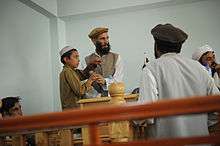Law of Afghanistan
 |
| This article is part of a series on the politics and government of Afghanistan |
|
Legislature |
|
Judiciary |
| Foreign relations |
The legal system of Afghanistan consists of Islamic, statutory and customary rules. It has developed over centuries and is currently changing in the context of the rebuilding of the Afghan state. The supreme law of the land is the Constitution of Afghanistan. In addition, there is complex legislation which stems from different historical periods. For instance, the so-called four volumes of civil law were developed on the basis of Egyptian models and promulgated in the time of the monarchy. Other legislation came into force under of President Daoud Khan, the Democratic Republic (1978-1992), the Mujahideen (1992-1996), the Taliban regime (1996-2001) and the current Islamic Republic of Afghanistan. Article 130 of the Afghan Constitution establishes that judges must apply the constitution and legislation and may only resort to Hanafi fiqh (one of the Schools of Islamic Law) if a necessary legal rule cannot be found in the written laws.[1]
Judicial System
Under the Taliban, there was no rule of law or independent judiciary. Ad hoc rudimentary judicial systems were established based on Taliban interpretation of Sharia (Islamic law). Murderers were subjected to public executions and thieves had a limb or two (one hand, one foot) severed. Adulterers were stoned to death in public. Taliban courts were said to have heard cases in sessions that sometimes lasted minutes. Prison conditions were very poor and prisoners were often not given much food. Normally, this was the responsibility of the prisoners' relatives, who were allowed to visit to provide food once or twice a week. Those who had no relatives had to petition the local council or rely on other inmates.

In non-Taliban controlled areas, only municipal and provincial authorities relied on some form of Islamic law and traditional tribal codes of justice. The administration and implementation of justice varied from area to area and depended on the whims of local commanders or other authorities, who could summarily execute, torture, and mete out punishments without reference to any other authority.
After the removal of the Taliban regime, Afghanistan's judicial system was fragmented, with conflicts between such core institutions as the Ministry of Justice, Supreme Court, and attorney general's office. In addition, the judicial system's infrastructure was destroyed; the absence of adequate court or ministry facilities, basic office furniture, and minimal supplies made substantive progress difficult. There were also tensions between religious and secular legal training with regard to appointments of new judicial personnel. Until Afghanistan's new constitution was adopted in 2004, the country's basic legal framework consisted of its 1964 constitution and existing laws and regulations to the extent that they were in accordance with the Bonn Agreement of 2001 and with international treaties to which Afghanistan was a party. The Ministry of Justice was charged with compiling Afghan laws and assessing their compatibility with international standards, but even it did not have texts of Afghan laws, which were largely unavailable, even among attorneys, judges, law faculty, and government agencies. While in power, the Taliban burned law books.
The 2004 Constitution established an independent judiciary under the Islamic Republic. The judicial branch consists of a Supreme Court (Stera Mahkama), High Courts, Appeals Courts, and local and district courts. The Supreme Court is composed of nine members who are appointed by the president for a period of ten years (nonrenewable) with the approval of the Wolesi Jirga. The Supreme Court has the power of judicial review. Lower courts apply Shia law in cases dealing with personal matters for Shia followers.
Crime in Afghanistan includes drug trafficking, money laundering, corruption, and black marketeering. The National Directorate of Security (NDS), Afghanistan's version of Homeland Security, has been accused of running its own prisons, torturing suspects, and harassing journalists, which has added to the controversy over human rights in the country.
Copyright law in Afghanistan has not been recognized by the United States since 2005. The court of last resort is the Afghan Supreme Court, which was approved in 2004 and is headed up by the Chief Justice of Afghanistan. The judicial system is still under construction.
See also
References
- ↑ Khan, Hamid M. (March 2015). Islamic Law, Customary Law, and Afghan Informal Justice. Washington, D.C.: United States Institute of Peace. Retrieved 31 May 2015.

